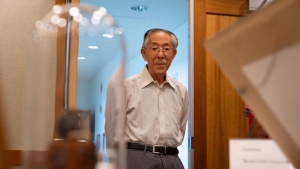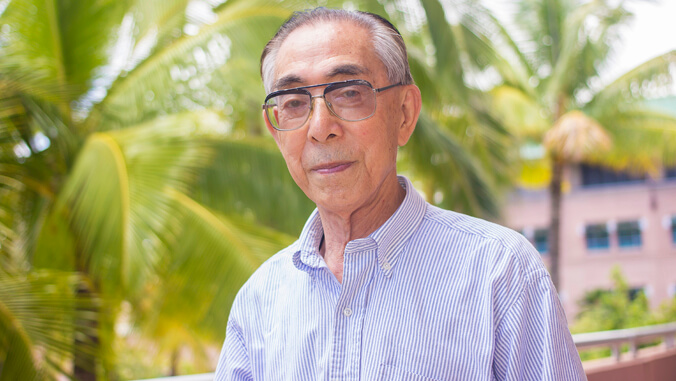Ryuzo Yanagimachi, whose pioneering contributions to reproductive biology and cloning have impacted millions of people and allowed families to grow, died on September 27, at the age of 95, the University of Hawaiʻi at Mānoa John A. Burns School of Medicine announced.

The renowned researcher began at UH Mānoa in 1966 as an assistant professor at JABSOM‘s Department of Anatomy and Reproductive Biology. Yanagimachi, or “Yana” as he was affectionately called, pioneered cloning and made numerous breakthroughs in mammalian fertilization and other fertilization techniques, such as intracytoplasmic sperm injection (ICSI). These techniques are used around the world in human infertility clinics.
“Dr. Yanagimachi’s research into cloning and IVF (in vitro fertilization) changed the world,” said Interim Dean Lee Buenconsejo-Lum. “Yana’s breakthroughs in cloning and IVF helped make the world a happier place for millions of families. His legacy is etched in history and at the University of Hawaiʻi John A. Burns School of Medicine. We are so honored that he was part of our ʻohana for so many years.”
Cloning breakthrough

In addition to his in vitro fertilization and intracytoplasmic sperm injection achievements, in 1997, at the age of 69, Yanagimachi cloned the world’s first mouse. This groundbreaking research was published a year later in the journal Nature, detailing how he removed the nucleus from a somatic cell (any cell in a living organism, other than reproductive cells) and injected it into an egg that also had its nucleus removed. The egg, bathed in a chemical solution and cultured, developed into an embryo, which was then implanted into a surrogate and allowed to develop. It is now known as the “Honolulu Technique.”
The first mouse born through the Honolulu Technique was named Cumulina. It symbolized the incredible possibilities unlocked by Yanagimachi’s pioneering work. That mouse is now in the Smithsonian in Washington D.C.
Contributions earn researcher accolades
His 38-year tenure and 18 years as professor emeritus were marked with many global breakthroughs.
Related: Yanagimachi wins Kyoto Prize for pioneering fertilization research, June 2023
Most notably, Yanagimachi was honored this year with the Kyoto Prize, an international award presented to individuals who have made significant contributions to science and technology, as well as the arts and philosophy. Many compare it to the Nobel Prize. Yanagimachi was recognized in the Biotechnology and Medical Technology category for his significant contributions to the development of essential assisted reproductive technologies in modern society through both basic research and technological development. He was scheduled to accept the award in November 2023.
When the award was initially announced Yanagimachi humbly said, “Although I was rarely directly involved in clinical investigations, I am very happy that some of the work we did played a role in bringing joy to many infertile couples.”
Yanagimachi received numerous awards, including the 1996 International Prize for Biology, Japan’s highest scientific award, and the 1999 Carl G. Hartman Award, the Society for the Study of Reproduction’s greatest honor. He was inducted into the National Academy of Sciences in 2001.
Shaping the future of research, mentoring leaders
In 2000, Yanagimachi founded and directed UH’s Institute for Biogenesis Research (IBR). The institute, devoted to studying embryogenesis, stem cell development, and transgenesis technology, would continue to push the boundaries of science. The faculty, staff and students cloned the first male animal from adult cells. In 2004, Yanagimachi’s team used intracytoplasmic sperm injection techniques to produce pups from an infertile male mouse. These achievements were critical moments in advancing research in human infertility.
In 2005, Yanagimachi retired, but continued active research. His passion for reproductive biology and cloning never waned.
“He was an innovative scientist and a great mentor. He was an inspiration to the faculty, staff, post-doctoral fellows, and students. He will always be part of our ʻohana,” JABSOM Associate Dean for Research Mariana Gerschenson said.
Throughout his illustrious career, Yanagimachi would also remember to pave the way for future scientists. Remembering his struggles breaking into the research field, Yanagimachi mentored and inspired up-and-coming researchers such as Monika Ward.
“My journey began in 1999 when I moved from Poland to Hawaiʻi as a graduate student,” Ward said “I wanted to work in Dr. Yanagimachi’s lab, but he didn’t have a spot for me at the time. He encouraged me to write for fellowships and grants. After writing for four or five grants, he was impressed with my determination, and the following year, I got hired, Yana had a policy of giving his postdoctoral fellows two days a week to pursue their own ideas. This encouragement to pursue other research venues resulted in the first cloned mouse by his postdoc Teruhiko Wakayama, who used the lab’s techniques to improve on cloning.”
Related: Renowned fertility researcher celebrated at inaugural symposium, August 2018
The current director of IBR, W. Steven Ward, said that IBR has flourished because of Yanagimachi’s initial leadership and continued example of excellence over the past 23 years of its existence.
“The IBR is populated by scientists who were trained by Yana, or recruited by him to join the work,” Ward said. “It is now a well established research institute world-renowned for its work on reproductive and developmental biology. Throughout his tenure at the IBR he was a constant source of possible new projects and wealth of instant knowledge of the field.”





